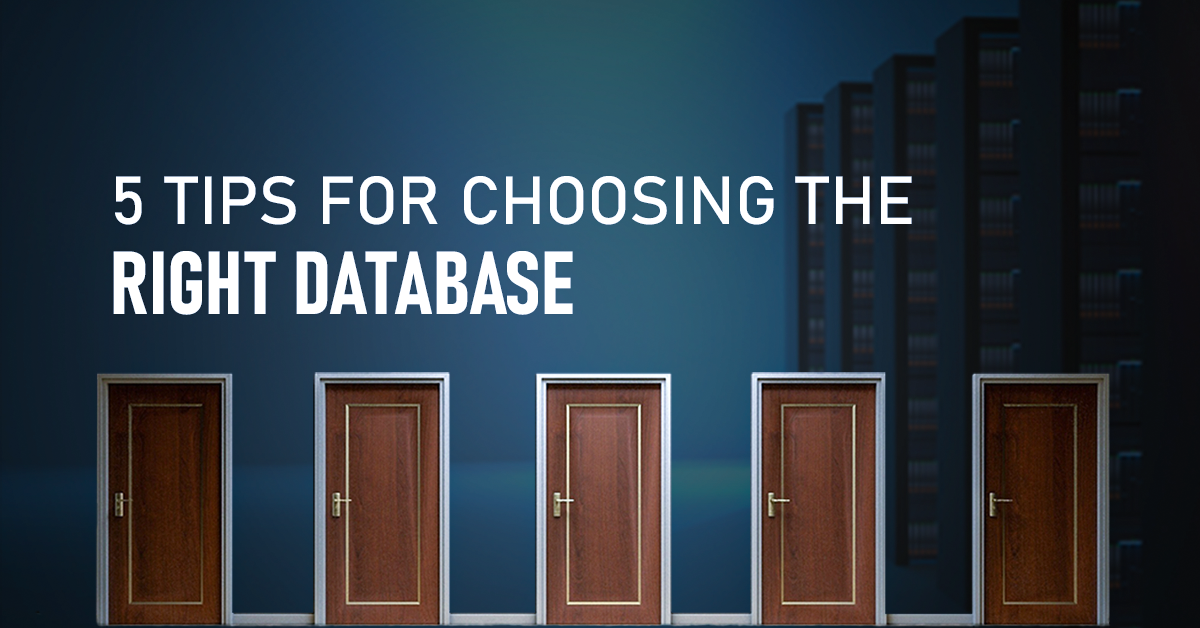5 tips for choosing the right database

Data Scientist
Deep learning and machine learning specialist, well-versed with experience in Cloud infrastructure, Block-chain technologies, and Big Data solutions.
May 05, 2022

Choosing the right database can be overwhelming given all the choices available as it is always important to capture diverse opinions when making a database decision. Taking time to make an informed choice of database technology upfront can be a valuable early decision as the right choice is not just one database, but maybe two or three. Data can be structured, like a SQL schema, or semi-structured, like a JSON object, where each matter can possess a unique shape; it could also have no specified configuration, like textual data for a full-text search or a key-value pair, which is not relatively distinct from a file phrase to file content connection. Before choosing blindly a kind of database, you need to start with the need as a lot of people think that choosing a database is choosing between SQL and no SQL, this is incorrect.
The preference of your database does not only entail how efficiently you can operate the data collected, but confiding on what you use it for, it could also impact your image as data could also be segregated by size, or the quantum of data produced (reads) or ingested (writes). To make sure you have a purposeful collection of data it is essential that you make a good choice of the database to use as the quality of the interactions determines user experience, thus affecting your image. Making the right choice is simpler; the most important factors are to consider the structure of your data, the size of your database, the speed you need to access your data, as well as the scaling of your database. There are more than 300 database management systems available in the market, and choosing the one can be overwhelming for developers, but choosing the wrong database for data-intensive applications unlocks a door to scaling challenges and extreme intricacy.
You have diverse possibilities available in relational and non-relational database but you need to understand none of them fits all kinds of projects requirement and each one of them has some strengths and weaknesses. The database that you simply select right now will impact your application and development efforts far into the future in the longer term. But a developer’s alternative of a database tends to be emotional and developers often select a database solely on what their applications need at the outset. If a database appears thrilling, a developer may just go with their gut and they may forego analyzing whether or not the database will work for their application sooner or later. Choosing the right database depends on finding the appropriate structure to deal with the type of application data and often by selecting the database with the appropriate structure, you can reduce development efforts to the minimum.
As far as choosing the right database technology, there are some ideas that every developer should go through as the developer may also be overwhelmed by having to choose between the many available databases. This can create paralysis followed by the choice of a database that addresses what an application begins out as. However, you don’t always know what all the use cases of an application will likely be. Applications tend to turn and start simple and grow to be complicated over time. So, what typically happens is that a developer begins with PostgreSQL, then adds MongoDB because they want to work with semi-structured data as they need a flexible schema. Adding Elasticsearch, the developer can do a log search or faceted search and when they find that it isn’t fast enough, they bring in Redis as a cache on top of that. Once they wish to do analytics, they spin up a data warehouse such as Snowflake. All of it gets confusing shortly, resulting in database sprawl leaving developers to worry about moving data between databases and using costly extract, transform, and load (ETL) processes. However, it doesn’t have to be that way as the builders can get all the things they want by taking a different approach. Here we are going to understand some of these concepts.
Glance further than the fast long term
A database is related to data or information in different formats and database migrations and re-platforming are no picnic. As you choose your database, keep in mind that you are making a choice that’s hard to undo and may lock you into a structure. Take into consideration whether your database of choice both meets your current requirements and can get you the place it is advisable in the future. You could be leaning towards just spinning up MongoDB and leaving it at that, but keep in mind that making a snap decision today may cause you heartache later on, and don't push all your requirements down to the database level.
Avoid cheating as you scale-out
When you want to create your database, you can cite and use some mature products. Conventional databases had been based on scale-up architectures and this meant if you wanted to go faster, you had to buy bigger hardware adding considerable expense to your efforts. However modern databases are typically based on scale-out architectures and you still need additional hardware, but the cost is proportional to the value you must add. So, it’s far more palatable as there's no reason why you have to go it alone. Understanding the appeal of scale-out architectures, old school databases like MySQL and PostgreSQL have patched in scale-out capabilities and one frequent method used to do that involves sharding or breaking the database into separate pieces (or shards). In conclusion, rather than having one giant MySQL instance, you might have 10 tinier MySQL instances.
Think carefully before you give up on a solution and try to solve the problems without changing the database first. Remember that if you happen to select a database provider that takes this approach to scale out, you may get into trouble if you need to run queries that have to share information across shards. Analytics-style queries, where you need to find the top clients in an area or probably the liveliest customers, can be particularly problematic in this type of structure.
Operate both hot and cold
Column stores are perfect for analytics as they allow you to scan large amounts of information shortly. Your application will consume plenty of time and will inquire for more developmental actions to fix any data-related crises if you are not proposing the right data structure to maintain your information or data here row stores are a better match for transactional workloads, which expect low latency lookups and updates. In the past, you had to decide between column-oriented and row-oriented storage in making a database choice. But you no longer need to make that tough alternative. Current databases that combine row and column storage into the same table are now accessible. In this scenario, information is written into an in-memory row store to allow extremely quick transactions and lookups. As data quiesces, colder data is written back to the column store and this lets you do efficient analytics on it as well. Developers need to choose a database with a strong system to solve conflicts as well.
Shift faster, but do not get physical
A major aspect of improving database performance is optimizing the read/write speed of magnetic disks and traditionally databases were designed around magnetic disks, which were the primary source of latency. While database vendors have formulated algorithms to minimize that latency, there are physical limits to the amount of time it takes for spinning disks and disk heads to get into place.
Tuning I/O can enhance performance if a disk containing database files is operating at its capacity and you can reduce IO-related delay by adopting a modern database with no moving parts. Solid-state drives (SSDs) are up to 200 times faster than spinning disks and to persist a database write, you just have to do an append. You get persistence by writing to a transaction log, appending to the transaction log and if you’re just doing read or lookup queries, you shouldn’t have to hit the disk in any respect.
Perceive that less is more
Database technology has changed and evolved over the years and databases of the past lack the speed, flexibility, and capability to support all of your applications. That’s why so many companies have amassed so many different databases over time. A database with an advanced partitioning system can easily store data in multiple systems and servers and your data-intensive applications call for a new kind of database.
Conclusion
All the tips mentioned above concerning the choice of the right database system can work in handy to help you choose the ideal model, for your database. Seek out a single database that permits you to scale competently and significantly simplify your architecture. A secure file system and data-level encryption also offer are also required to secure data on both server and client-side. Discover a database designed to handle both transactional and analytical workloads and does quick analytical queries across large, dynamic data sets with high concurrency. And utilize a multi-model database that addresses all data types. Intelligently, pick the best database to solve a specific problem or a group of problems.













